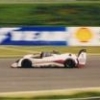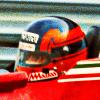I have produced and/or directed network motorsports in the USA since back in the early nineties, starting with tape-delayed NHRA drag racing. We initially had seven track coverage cameras and only three one inch tape machines that were replay capable, and 2 smaller, non-playback tape machines. We recorded the line cut of the race on one machine and one backup, switched individual cameras (including in-car camera feeds) to another machine and then had a tape operator do an alternate "subcut" of the race as well. We rarely missed anything but would have loved to have more record capability and therefore more replay opportunities.
By the mid-nineties, the EVS machine came along. It used hard drives instead of tape, and early versions could take four cameras in at once and play back two of them. With two EVS units, you could then handle up to 8 camera sources for replays with one operator handling each machine. About that time we began doing the NHRA events live, so it made our coverage complete enough that we added more cameras and needed more machines.
The replays were basically handled by a tape producer who looked for the best replay angles, and then told me and the director which machine had the best replays and suggested the best sequence. The tape room in the truck was also configured for editing individual shots into sequences and full highlight packages. The tape room was also linked with a separate truck that handled the pit cameras and the various on-board cameras.
The companies I worked for also covered sprint cars, motorcycle road racing, motorcross, stock car racing, offshore and hydroplane racing, and we would almost exclusively use the EVS machines for isolated camera recordings and replays. At the end of the day, we would transfer the best material to a tape that would serve as an archive of that race.
During my time doing the last years of the Champ Car series, we could have 20 or more video feeds, comprised of track cameras, pit cameras and on board cameras, but never enough EVS machines to handle all sources. When I see current race coverage, such as F1, with every car having an in-car feed, I get extremely jealous...
By the 2000s, we also routed the director in one ear and program audio/announcers in the other ear of the camera operator's twin muff headsets. It enabled us to respond faster to show whatever the announcers were discussing. As always, the camera operators could inform the truck of things that they had seen and shot, and the camera operators could also help notify the next camera in the sequence of a new development.




















